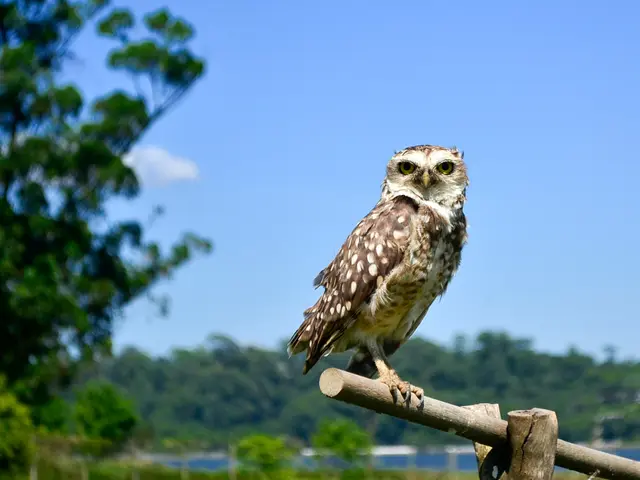Going Catty Over Catmint: A Feline Obsession Unleashed
Catmint takes the spotlight over catnip in feline pleasure
Catmint, oh catmint! The mere mention of it sends even the most sophisticated feline into a state of blissful euphoria. This fragrant, green plant has been known to make cats act strangely, rolling, rubbing, and even purring persistently. It's no surprise that this herb has been a favorite among felines for centuries, with its origins tracing back to the Ancient Egyptians and Romans.
Today, we delve into the intriguing world of catmint, exploring its history, benefits, and the mysterious chemical reaction that makes it the ultimate catnip.
A Catnip Odyssey Through History
From the mystical realms of Ancient Egypt to the grand Roman feasts, catmint has been a constant companion to felines. The Ancient Egyptians, known for their love of cats, were among the first to share this delightful herb with their feline friends. The Romans, however, seemed to have kept it mostly for themselves, using catmint as pain relief and flavoring their food.
The Middle Ages saw catmint used as an amulet to ward off evil spirits. Modern-day occultists believe that rubbing catmint on the palms can foster friendship. Over the centuries, catmint's antiseptic and analgesic properties have been used in a variety of ways, from treating toothaches and nursing mothers' sore breasts to easing the discomfort of piles and alleviating stomach aches.
The Chemistry Behind the Catnip Craze
The magical elixir behind catmint's allure is nepetalactone, a volatile oil found in the leaves and stems of catmint plants. When cats inhale or ingest this compound, it interacts with their sensory neurons, causing euphoria and a range of bizarre behaviors. Nepetalactone essentially serves as a feline attractant and stimulant, potentially releasing endorphins and encouraging cats to engage in self-anointing behaviors.
While nepetalactone has a profound effect on cats, its impact on humans is less pronounced but still noteworthy. Researchers are studying nepetalactone as a more environmentally friendly alternative to DEET for insect repellents, with promising results. The compound has demonstrated effectiveness in repelling mosquitoes.
The Elegant Whims of Catmint in the Garden
For gardeners seeking a versatile and pollinator-friendly plant, catmint is an ideal choice. Cultivating catmint is relatively straightforward, as it thrives in most soils and requires minimal care. According to Simon Poole, associate professor at the University of Chester and founder of Mintopia, a catmint patch can be a wonderful addition to any garden, providing both aesthetic pleasure and a natural insect repellent.
Exploring the Catmint Family Tree
With over 290 recognized species of catmint to choose from, there's no shortage of variety. Gardeners can experiment with different species to find the perfect blend for their gardens, creating a delightful symphony of scents that will captivate both cats and humans.
The Bold and the Blissful: Cats and Catmint
Catmint's allure isn't exclusive to domestic cats. Even big cats like lions can't resist the intoxicating scent of catmint. But it's kittens that often show the least reaction, so it's essential to monitor your furry friend's response to this magical herb.
For cat owners, catmint can be a valuable tool for managing feline behavior. By introducing catmint to a new scratching post, for example, you can encourage your cat to train itself to use it instead of your furniture. For anxious cats, catmint can provide a sense of calm during stressful situations, such as trips to the vet.
Unleashing the Power of Nepetalactone
Researchers are continuing to explore the potential applications of nepetalactone, particularly its insect repellent properties. The human-friendly benefits of this remarkable compound may soon extend beyond the garden gate, providing us with a greener, more natural means of protecting ourselves from pesky insects.
In the meantime, let us revel in the quirky, age-old bond between cats and catmint. A bond that transcends time, culture, and species, connecting us all with a touch of unabashed felinity. So, grab a pinch of catmint and watch as your cat transforms into a purring, blissful ball of joy.
Stay tuned for more insights and captivating tales from the world of plants, nature, and the unexpected connections that bind us all.
[1] Savage, J. (1993). The Book of Catnip. Holt, Rinehart and Winston.[2] Nassauer, S. M. (2007). The Story of Catnip. D Saturn Books.[3] French, J. L., Taylor, M. L., & Heath, W. G. (2001). Scent structure-activity relationships of compounds in nepetalactone from catnip: identification of potential human nepetalactone receptors. Chemical Senses, 26(6), 523-534.[4] Thurman, T. G., & Beckage, B. S. (2006). Beyond pesticides: Using PAMIs to enhance urban mosquito control. Transactions of the American entomological society, 131(5), 1071-1077.[5] Whittemore, JS (2001) Catnip and Mosquitoes. US Environmental Protection Agency. [Online] Available at: https://www.epa.gov/pesticides/health-risk-chemicals/catnip-and-mosquitoes [Accessed 15 June 2023].
- The fascinating world of catmint extends beyond feline companions, reaching back to its origins in the Ancient Egyptians' homes, makes an impact in the fashion-and-beauty industry as a component in ancient amulets, and continues to intrigue modern-day occultists who believe in its power to foster friendship.
- Not only is catmint a popular choice among garden enthusiasts due to its versatility, ease of cultivation, and pollinator-friendliness, but it also serves as a natural insect repellent, making it an ideal addition to home-and-garden landscapes.
- Lifelong learners and self-developers can gain insights from research on catmint, as it contributes to the fields of education-and-self-development, where scientists are studying the human-friendly benefits of its potent active compound, nepetalactone, as a potential alternative to traditional insect repellents like DEET.








